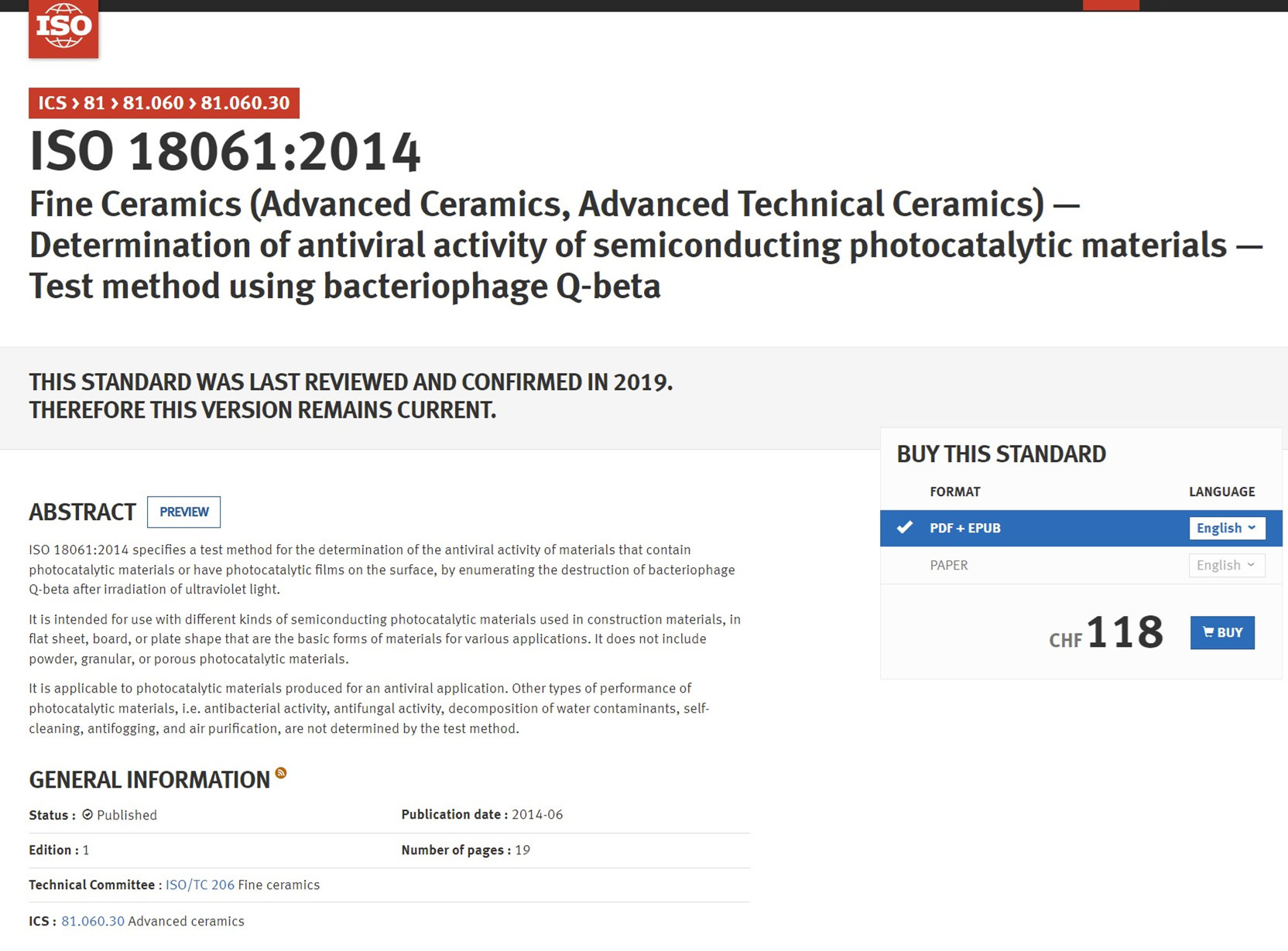精细陶瓷(高级陶瓷, 高级工业陶瓷). 半导体光催化材料的抗病毒活性的测定. 采用噬菌体Q-β的试验方法
时间:2022-03-14 14:32:53 来源:ISO 点击量:

ISO 18061-2014 精细陶瓷(高级陶瓷, 高级工业陶瓷). 半导体光催化材料的抗病毒活性的测定. 采用噬菌体Q-β的试验方法
ISO 18061:2014 Fine Ceramics (Advanced Ceramics, Advanced Technical Ceramics) — Determination of antiviral activity of semiconducting photocatalytic materials — Test method using bacteriophage Q-beta
Introduction
This International Standard applies to testing the antiviral activity of photocatalytic ceramics and other materials produced by either coating or mixing of a photocatalyst. The International Standard for testing the antibacterial activity that use photocatalytic materials has been published as ISO 27447. The International Standard for testing the antifungal activity that use photocatalytic materials has also been published as ISO 13125.
The test method for cloths or textiles is not included in this International Standard because of lack of photocatalytic cloths or textiles with antiviral activity using photocatalytic activity. When photocatalytic cloths or textiles with antiviral activity using photocatalytic activity have been developed, a test method for photocatalytic cloths or textiles will be proposed with the glass adhesion method in ISO 27447.
WARNING Only personnel trained in microbiological techniques should carry out tests.
1 Scope
The test method in this International Standard specifies the determination of the antiviral activity of materials that contain photocatalytic materials or have photocatalytic films on the surface, by enumerating the destruction of bacteriophage Q-beta after irradiation of ultraviolet light.
NOTE In this test method, the surrogate microbe is bacteriophage Q-beta, intended as a model for Influenza viruses.
The test method in this International Standard is intended for use with different kinds of semiconducting photocatalytic materials used in construction materials, in flat sheet, board, or plate shape that are the basic forms of materials for various applications. It does not include powder, granular, or porous photocatalytic materials.
The test method in this International Standard is applicable to photocatalytic materials produced for an antiviral application. Other types of performance of photocatalytic materials, i.e. antibacterial activity, antifungal activity, decomposition of water contaminants, self-cleaning, antifogging, and air purification, are not determined by this test method.
The values expressed in this International Standard are in accordance with the International System of Units (SI).
2 Normative references
The following documents, in whole or in part, are normatively referenced in this document and are indispensable for its application. For dated references, only the edition cited applies. For undated references, the latest edition of the referenced document (including any amendments) applies.
ISO 10677, Fine ceramics (advanced ceramics, advanced technical ceramics) — Ultraviolet light source for testing semiconducting photocatalytic materials
ISO 27447, Fine ceramics (advanced ceramics, advanced technical ceramics) — Test method for antibacterial activity of semiconducting photocatalytic materials
ISO 80000-1, Quantities and units — Part 1: General
3 Terms and definitions
For the purposes of this document, the following terms and definitions apply.
3.1
photocatalyst
substance that carries out many functions based on oxidization and reduction reactions under photoirradiation, including decomposition and removal of air and water contaminants, deodorization, and antiviral, antibacterial, antifungal, self-cleaning, and antifogging actions
3.2
photocatalytic materials
materials in which, or on which, the photocatalyst is added by coating, impregnation, mixing, etc.
Note 1 to entry: Photocatalytic materials are used for building and road construction materials to obtain the functions mentioned in 3.1.
3.3
antiviral
condition decreasing the infectivity of viruses on the surface of materials
3.4
bacteriophage
type of virus which infects bacteria
Note 1 to entry: The bacteriophage used in this test method is Q-beta that is one of F-specific RNA phages. The bacteriophage Q-beta is not pathogenic to humans and animals but serves to simulate Influenza viruses that are pathogenic to humans.
Note 2 to entry: Example of test results with Influenza virus and bacteriophage Q-beta are given in Annex A.
3.5
plaque
visible, clear area which is theoretically the result of infection and lysis of host cells by a single viable bacteriophage
3.6
photocatalyst antiviral activity value
difference value between the logarithms of the total number of bacteriophage plaques on photocatalytic treated materials after UV irradiation and on non-treated materials after UV irradiation
Note 1 to entry: This value includes the decrease of number of bacteriophage plaques without UV irradiation.
3.7
photocatalyst antiviral activity value for UV irradiation
difference between the logarithms of the total number of bacteriophage plaques on photocatalytic treated materials after UV irradiation and on photocatalytic treated materials kept in the dark
CIAA会员单位免费下载
